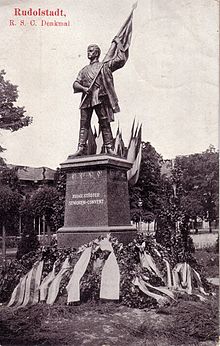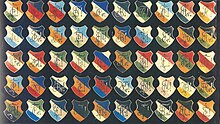Rudolstadt Senior Citizens' Convention
The Rudolstädter Senioren-Convent (RSC) was a corporation association .
history
Founded until 1910
As early as the 1850s, student corporations were formed at the veterinary colleges , called Landsmannschaft or Corps and initially used both terms side by side. There they formed the most important form of the written student body . It was only after lengthy negotiations that Franconia Berlin, Feronia Berlin , Hannoverania and Normannia Hanover founded the "Berliner SC der veterinairmedizinischen Landsmannschaften" in 1873, which was joined a year later by the connections Hippokratia Munich (later Corps Normannia Munich in the WSC) and Salingia Berlin. With the departure of Salingia and a little later also Franconia and Normannia, the association broke up again in 1876.
On July 9, 1883, the association was renewed as the Rudolstadt Seniors' Convent by the Berlin and Hanoverian Landsmannschaften together with Saxonia Dresden, which was founded in 1879 (after the Dresden University of Veterinary Medicine was relocated to Leipzig in 1923 and connected to Saxo-Borussia Leipzig) . Its meetings took place annually at Whitsun in Rudolstadt . Suevia Stuttgart joined in 1884, Nicaria Stuttgart in 1885, Cimbria Stuttgart in 1891, Alemannia Dresden in 1894 and Germania Hanover in 1895.
Through further growth, the association had 15 country teams by 1900. At that time it comprised 38.33% of all students at the German veterinary universities. In 1902 it was decided that all member associations should rename themselves to Corps .
The Altherrenbund (AHB) of the RSC was founded in March 1908 in Hanover . It was based in Rudolstadt and was entered in the register of associations there. Its purpose was "to look after the common interests of the entire old rulers in the RSC and to support the active corps with advice and action". The AHB meetings were held annually at Whitsun in the Hotel zum Löwen in Rudolstadt.
The expansion phase
When the University of Veterinary Medicine in Stuttgart was closed in 1910, the local corps Suevia and Nicaria moved to Munich and merged with local corps. The increased involvement of veterinary training in the universities worsened the conditions for an expansion of the association. The veterinary principle was therefore abandoned in the same year, whereupon other corps - mainly from technical universities and commercial colleges, but also occasionally from universities - joined the RSC. The latter led to massive conflicts with the Kösener Senioren-Convents-Verband (KSCV) and the Weinheimer Senioren-Convent (WSC), which on the one hand never viewed the RSC Corps as full partners, on the other hand they saw their monopoly position at risk. As early as 1911, the RSC u. a. the free Landsmannschaft Cheruscia Berlin, the uncovering connection Saxonia Berlin, the free Landsmannschaft Silingia Breslau , the freeing connection Teutonia (later Gothia) at the military department of the Veterinary University in Dresden and the uncovering connection Guestphalia Erlangen.
By the winter semester of 1919/20, the number had grown to 24 corps with 452 active, 230 inactive and 3546 old men. The RSC was able to gain a foothold there with the establishment of the Hubertia and Silvania connections, reconstituted as corps in Giessen , who had moved there from the Eisenach Forest Academy. At the Silesian Friedrich-Wilhelms-Universität in Breslau , the connection to Lugia was opened in the same year. In 1922, the Frisia Frankfurt connection and the Corps Vandalia and Palaio-Borussia Königsberg followed.
As a result of the restructuring of the veterinary universities (including relocation from Dresden to Leipzig), the contrast to the WSC intensified when the RSC corps there moved their headquarters to the technical university. A balance was initially achieved with the establishment of the Working Group of the German Corps Associations on October 7, 1922 in Rudolstadt, in which the KSCV, WSC and RSC agreed on closer cooperation.
The Rudolstadt Agreement was supplemented by an additional agreement in December 1922, which stipulated that in future there would no longer be any relocation to a university without the consent of the existing corps association. When new universities are founded, the right of establishment should belong to the KSCV at universities, the WSC at technical universities and mining academies, and the RSC at all other universities. This passage put the RSC at a disadvantage, as it had already been broken by the inclusion of the SC at the Tharandt Forest Academy in the KSCV (1922) and the SC at the Agricultural University in Hohenheim in the WSC. It was therefore not approved at the subsequent Whitsun meeting of the RSC. Shortly before, however, the KSCV had terminated the agreement.
Despite this setback and despite the tightening of the admission requirements, the RSC increased its number to 52 corps by 1927 with 1,674 active, 939 inactive and 5,559 old men. Among the new admissions in 1923 was the Corps Rheno-Nicaria Mannheim , which fell into the area of the RSC as a commercial university connection.
A serious crisis brought with it the efforts to expand the association by including the Askanischer Senior Convent (Corps Germania, Suevia, Baltia; Landsmannschaft Askania). In the course of these disputes, 19 corps left the association, including Salingia and Saxonia Berlin (1929), the Green Cartel (Franconia Berlin, Normannia Hanover, Suevo-Salingia Munich), Saxo-Borussia Leipzig, Cimbria and Prussonia Berlin, Silvania and Hubertia Gießen, Palaio-Borussia Königsberg, Moenania Frankfurt / M , Askania Vienna and Agronomia Jenensis. By May 1931 the number had fallen to 30 active corps with 1,820 active and inactive and 3,721 senior men.
Dissolution and afterlife
On March 25, 1934, the RSC decided to dissolve and merge with the Weinheim Senior Citizens 'Convention (WSC), which in the same year also integrated parts of the Naumburg Senior Citizens' Convention (NSC). After the Second World War, the WSC was revived as the umbrella organization of the German corps, primarily at technical universities, with the corps of the former RSC today being an integral part of the WSC, which continues the tradition of the association. Only the Corps Guestphalia Erlangen was recipients of the KSCV in 1935.
From June 12 to 15, 2008, around 300 Weinheim Corps students celebrated the 125th anniversary of the founding of the RSC in Rudolstadt. The Mayor of Rudolstadt, Jörg Reichl, said in a speech at the ceremony: "Come back, feel at home here, let the tradition of the Rudolstadt Whitsun meetings come back to life!"
Monuments
In 1908, on the occasion of the 25th anniversary of the association, the RSC memorial created by Norbert Pfretzschner was erected in the presence of the Schwarzburg court, the ministry and the authorities on the Anger in Rudolstadt . Conrad Klinger (Franconia Berlin) was the model for the statue of a charge in Wichs with a flag.
The memorial for those killed in the First World War in the city park of Rudolstadt was built according to plans by the Dresden architect Max Herfurt and inaugurated on Whitsunday 1927. It consists of a sixteen meter diameter stone circle in the style of a Druid temple with sixteen roughly hewn steles. Inside there was a bronze plaque with the dedication of the RSC, on the side facing the Saale there was a larger than life-size stone Roland figure by the sculptor Hermann Fritz.
Press
The organ of the association was the monthly Rudolstädter SC , founded in 1894 and published until 1934.
Personalities
- Otto Appel (1867–1952), phytomedicist
- Hans Bredow (1879–1959), high-frequency technician and chairman of the Reichs-Rundfunk-Gesellschaft (RRG)
- Max Delbrück (1850–1919), agricultural chemist
- Richard Eberlein (1869–1921), veterinarian, zoologist and doctor
- Wilhelm Ellenberger (1848–1929), professor of veterinary anatomy and physiology
- Abraham Esau (1884–1955), physicist
- Guido Fischer (1877–1959), dentist
- Carl-Theodor Georg (1884–1966), doctor, plantation owner and hospital founder in the Dominican Republic
- Emil Jacobsen (1836–1911), chemist and writer
- Walter Langhoff (1883–1944), industrialist, leader of the General German Arms Ring
- Bernard Malkmus (1859-1925), veterinarian
- Kurt Neumann-Kleinpaul (1882–1958), veterinarian
- Hans Klose (1880–1963), nature conservation official
- Heinrich Nicklisch (1876–1946), economist
- Karl Nieberle (1877-1946), veterinarian
- Robert von Ostertag (1864–1940), veterinarian
- Wilhelm Pfeiffer (1867–1959), veterinary surgeon
- Theodor Schiemann (1847–1921), historian and archivist, founder of German research on Eastern Europe
- Karl Wilhelm Specht (1894–1953), General of the Infantry
- Wolfgang Stammler (1886–1965), Germanist and literary historian
- Valentin Stang (1876–1944), veterinarian
- Max von Sussdorf (1855–1945), veterinarian
- Heinrich Tessenow (1876–1950), architect
- Hermann Thoms (1859–1931), pharmacist
- Alfred Trautmann (1884–1952), veterinarian
- Otto Waldmann (1885–1955), animal disease researcher
See also
literature
- Albert Bundle: Rudolstädter Senioren-Convent (RSC) , in: Academic Germany, Vol. 2: The German universities and their academic citizens . Berlin 1931, pp. 287-297.
- Heinrich Diedler: The Rudolstadt Senior Citizens' Convention. Brief description of the history of an old corps formation . Once and Now, Yearbook of the Association for Corporate Student History Research, Vol. 47 (2002), pp. 295-312.
- [Heinrich] Diedler: The RSC at the end of the Weimar Republic until the association was liquidated . In: Corps 1/2008, p. 23f.
- Heinrich Diedler: The RSC. History of an extinct corps association . Einst und Jetzt, Vol. 55 (2010), pp. 219-366. ISBN 3-87707-781-1 .
- Wolfgang Neugebauer: The memorial for the fallen of the RSC . Einst und Jetzt, Vol. 40 (1995), pp. 191-192.
- Wilhelm Rieck: History of the Rudolstädter Senioren-Convent , in: 100 years Weinheimer Senioren-Convent. Bochum 1963, pp. 67-74.
- Carl Wittlinger: Foundation, development and principles of the AHB in the RSC , in: The Academic Germany, Vol. 2: The German universities and their academic citizens . Berlin 1931, pp. 299-302.
Web links
Individual evidence
- ^ Wilhelm Rieck: History of the Rudolstädter Senioren-Convent , in: 100 years Weinheimer Senioren-Convent. Bochum 1963, p. 73.
- ↑ Diedler: The RSC at the end of the Weimar Republic to the liquidation of the Association . In: Corps 1/2008, p. 24.
- ^ Corps - the magazine. Erbach 2008,3, p. 19. ISSN 1615-8180
- ^ Wilhelm Rieck: History of the Rudolstädter Senioren-Convent , in: 100 years Weinheimer Senioren-Convent. Bochum 1963, p. 69.
- ↑ Wolfgang Neugebauer: The monument of the fallen of the RSC. In: then and now. Yearbook of the Association for Corporate Student History Research. Volume 40 (1995), p. 191 f.




